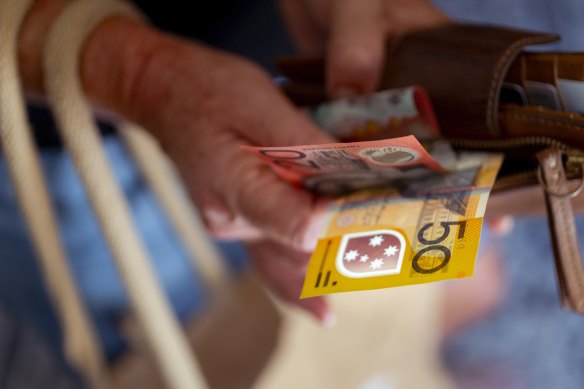This was published 9 months ago
Opinion
Forget tradies. It’s the kids who’ll suffer if cash disappears
Nicole Pedersen-McKinnon
Money contributorWon’t someone think of the children? Last week we took another distressing step towards losing a vital teaching tool for our kids: cash.
Analysis by Canstar of the latest APRA data reveals 4518 ATMs have been removed from service by our big four banks in the past five years – mostly, perhaps surprisingly, from the major cities. And the news comes hot on the heels of Westpac’s decision the previous week to stop offering cardless cash withdrawals – say, with a phone or watch – across the country.
The bank cited a decline in use, in favour of the “speed, security and convenience” of mobile wallet transactions. From 70 per cent of transactions being in physical currency in 2007, the RBA’s latest Consumer Payment Behaviour Bulletin showed it was just 13 per cent in 2023.

Using cash is still the best way to help children become fabulous money managers.Credit: Dominic Lorrimer
Well, forget tradies – it’s our kids who will suffer the most if cash goes kaput.
My Miss 11 summed it up perfectly the other day: “When I spend money from my pocket money card, Mamma, I don’t really care. When I spend car-washing cash [her main source of extra earnings], I really think about it.”
She encapsulated the well-documented phenomenon of coupling. No matter what your age, dip into your cash for a purchase and there’s an immediate dollar detriment… and discomfort. But use a card or any electronic form, and the financial hurt is hidden and indeed may not come until way later.
Invisible money is scarily psychologically disposable. So how – as parents – can we best wrap young minds around the fact that something you barely see any more is not just precious but finite?
In the fast march to digital, some tech is helping. Firstly, there are some fabulous apps out there with “kid-tastic” tools to engage them with money and its worth.
That brings some good salience to something that is increasingly not. But there are two things your child must internalise about money, if they are to be any good with it. The first is that it can get you amazing things… if you identify what you want and (usually) plot a clear path towards it.
Goals are and should be the fun stuff. And they should be so sweet that kids can almost taste them.
And it’s not just apps - bank account interfaces for kids often have decent goal-targeting functionality. The more visual and aspirational the better, and progress bars (or the like) work well.
However, inherent in achieving your goals with finite resources, and saving for something, is giving up other things. As adults, we know that. (If you haven’t yet learned it, you may be in a spot of financial bother.)
Pain in the game
That brings me to the second key to creating fabulous money managers. There’s increasing gamification in the available tech tools for children, with which your kids will probably identify well and of which (so long as it doesn’t border on gambling) I’m a fan.
But there must be ‘pain’ in the game… and in the real world as well. Yes, spending decisions need to hurt. Unless it’s a present, everything from virtual Roblox currency to actual Lego should personally cost them, at least a little bit.
And a related concept to their future economic comfort is that waiting – and foregoing other tempting things along the way – produces ultimate enjoyment.
Getting back to Miss 11, she uttered this telling comment the other day when I took her shopping with cash she’d collected, and she fell in ‘love’ with a shirt: “If I didn’t have to use my money, I’d buy it… but I won’t spend mine.”
She didn’t love it that much. And, once again, it was her cash that gave her cause for pause. That’s payment ‘coupling’, from before, in action. At the time, she was wholly focused on saving hers for something next-level appealing: converting the maximum amount possible to dong to spend on her recent trip to Vietnam.
And she impressively delayed other gratification in the lead-up.

The festive season provides ample opportunities to teach your kids about money.Credit: Aresna Villanueva
There’s a nice little financial literacy trick I use when it’s my cash too. It works wonders to trigger my daughter’s restraint and assiduous allocation of money … if I send her into the grocery store with, say, a $20 note and tell her she can keep the change. She fashions meals cheaper than I ever could!
Here’s a fascinating thing, though: precisely because she finds it less uncomfortable to spend (and there’s also the online gaming impetus), my little girl usually gives me back any cash she earns from me, and asks me to immediately swap it for digital currency on her card.
No matter. I’ll keep putting money physically in her hand… if only for an important (teaching) moment. For as long as we can still access cash, that is.
Nicole Pedersen-McKinnon is the author of How to Get Mortgage-Free Like Me, available at www.nicolessmartmoney.com. Follow Nicole on Facebook, X and Instagram.
- Advice given in this article is general in nature and is not intended to influence readers’ decisions about investing or financial products. They should always seek their own professional advice that takes into account their own personal circumstances before making any financial decisions.
Expert tips on how to save, invest and make the most of your money delivered to your inbox every Sunday. Sign up for our Real Money newsletter.